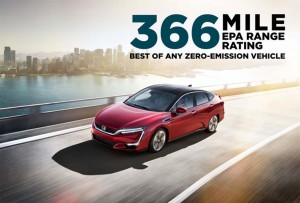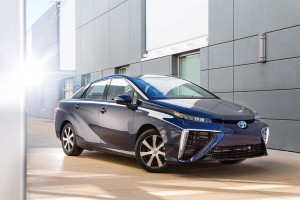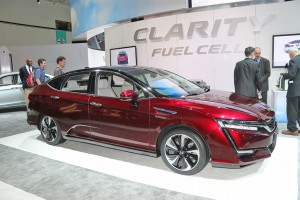Better late than never – especially if you can come to market with the longest range of any zero-emission vehicle, it seems.
The new Honda Clarity Fuel-Cell Vehicle will deliver an average 366 miles on a tank of hydrogen, and yield the equivalent of 68 miles per gallon, according to EPA testing. Its debut pushed back by a year, the Clarity now becomes the third hydrogen-powered vehicle on the U.S. market, following a fuel-cell version of the Hyundai Tucson and the new Toyota Mirai.
“Not only does the Clarity Fuel Cell fit five passengers and refuel in three to five minutes, it offers customers a driving range on par with gasoline-powered cars,” said Steve Center, head of environmental business development for American Honda Motor Co.
(What! You didn’t celebrate Hydrogen Day? Click Here to see what you missed.)
Range anxiety is a problem for all zero-emissions vehicles, or ZEVs. Most battery-electric vehicles can manage only about 100 miles per charge, though a new generation of products, such as the Tesla Model S, has begun to offer range closer to that of a gasoline-powered vehicle. And newer battery-cars, such as the Tesla Model 3 and Chevrolet Bolt, will bring prices down to more mainstream levels, as well.
Using the latest in high-pressure storage technology, fuel-cell vehicles, or FCVs, can readily handle ranges of 300 miles or more. And they offer the advantage of fast fill-ups – typically under five minutes – compared to the hours it can take to fully recharge a battery.
But FCVs have their own range anxiety issues. In a statement announcing the new EPA ratings, Honda suggests that “the zero-emissions family road trip is no longer science fiction.” But the reality is that once the Honda Clarity goes on sale before the end of the year, buyers won’t be able to stray very far.
The new model will only be offered to select buyers through 12 approved dealers in Northern and Southern California. That’s because there are currently just a handful of public hydrogen filling stations, almost all of them in the Orange County suburbs of Los Angeles, near San Francisco and up by the state capital in Sacramento.
California legislators have authorized funding for a larger network, but that likely won’t be fully in place before the end of the decade. And it’s unclear how long it might take to create a nationwide refueling infrastructure. That could depend upon how consumers respond to the three new hydrogen cars and several others set to reach the California market over the next three to four years.
“This could be a ‘now or never’ situation for FCEVs (fuel-cell electric vehicles) in mass market mobility,” Ben Scott, a senior IHS analyst, noted, as part of a study the research firm released in May.
On the plus side, the short time it takes to fill up a hydrogen tank should be a plus, Scott suggested. “Refueling habits with an FCEV will be very similar to that of a conventional car. This will definitely help with customer acceptance of FCEVs.”
(The Army has enlisted GM to send a hydrogen pickup to the front lines. Click Here for more.)
Honda has not said precisely when it will begin selling the new Clarity, nor has it set a price, but that’s likely to come in at around $400 a month, in line with what Hyundai and Toyota are asking. Honda may also offer unlimited fuel as part of the deal, as do those two competitors.
Honda was actually the first automaker to offer a hydrogen car to the American public. It leased a small number of the original FCX model nearly a decade ago before pulling the vehicle off the market.
While it remains to be seen if there will be much of a market for hydrogen power in the U.S., there’s an even more aggressive push to market the technology in both Japan and Korea, both countries hoping to have significant numbers of fuel-cell vehicles on the road by the beginning of the next decade.
(Toyota testing fuel-cell vehicles ahead of upcoming Tokyo Olympics. Click Here for the story.)



